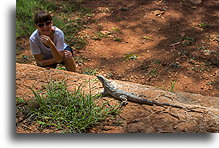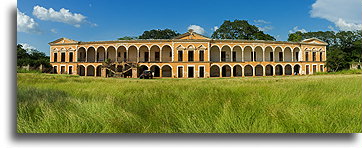From the ruins to church procession
October 14



We spent another night in Uxmal. In the morning, we went to Labna. This archeological site is relatively small and compact. Estimated is that only about 2,000 inhabitants occupied the area. We came here to see another Maya gate. The arch was not an entrance to the city, like the one in Kabah, but rather is a passageway between upper class residential area and the main plaza with administrative buildings. The structure is 6 m/ 20 ft high and is an example of the Puuc architectural style.





The Palace in Labna constructed between AD 750 – 1000 has about 70 rooms and 7 patios. God Chaac masks dominate in the façade decorations. Certain areas of the Palace had different uses like administrative activities, or preparation of food. One wing contained living quarters for member of the upper class. Where did common people live? Usually they lived around the city in traditional oval houses made with wood and mud clay. We noticed a reconstruction of such a house in Labna. It was an inspiration for us to trace Maya houses still in use in the in the villages we cross in this part of Yucatan.




From Labna we went to the nearby Loltun Cave. For centuries, Maya used this cave as a shelter, leaving many traces of their presence behind. The underground trail is 2 km long. We saw rock carvings and so-called "black hands" painted using a negative technique. The cave also contains "Maya trenches,” built during the Caste War of Yucatan in the second half of the 19th century, when Maya used this grotto as a hideout.



What is the negative technique in the process of leaving an image of your own hand? We learned that it is quite easy. All you have to do is fill the mouth with ashes from the fire, put your hand on the rock, and spit out the ash on your hand and its surroundings. Centuries later, archaeologists will be busy analyzing the hand image. If they can extract DNA from saliva left on the rock, they can learn a lot about you.



The haciendas of Yucatán were the basis of an economic system introduced by Spaniards in 16th century. Similar to the American southern plantations they were built by the wealthy to produce goods that could be sold with a tremendous profit. Each hacienda was a rural, autonomous social unit. There was usually the main building of the owner or manager, a chapel and a shop for workers, sometimes a school. Cane sugar was sometimes produced, but production of rope for shipping industry dominated. Such production based on Sisal, the species of Agave cultivated for fiber. The haciendas maintained huge fields of Sisal that required hundreds of workers. To maximize profits haciendas enforced race-based caste system. Maya were at the lower level of the ladder. They were not slaves officially, but the system was similar to the feudal system. European-descended population, called Yucatecos held the economic control, Maya were workers paid only the bare minimum. Our trip to world of the Maya would be incomplete without visiting a few haciendas in Yucatán.






This is why we went to Hacienda Tabi. We had no idea that this place was not open to the public. We followed a road between abandoned citrus plantations until we reach a gate. It was open and we drove inside. To our eyes appeared the huge main house or Casa Principal in front of which we parked. In a short time, a man appeared who demanded us to leave. He looked like a person looking after this uninhabited hacienda. With a help of two baseball hats I was able to assure him that we are peaceful visitors. He let us stay for a few hours; we had time to explore the abandoned hacienda.





On the way back to Uxmal, we stopped in a small town of Ticul. It was time to fill our water tanks and buy groceries. While in town, we witnessed a solemn march of residents. Women in white dresses decorated with flowers dominated this church procession. Many people carried gifts in their hands, bread or food trays.














